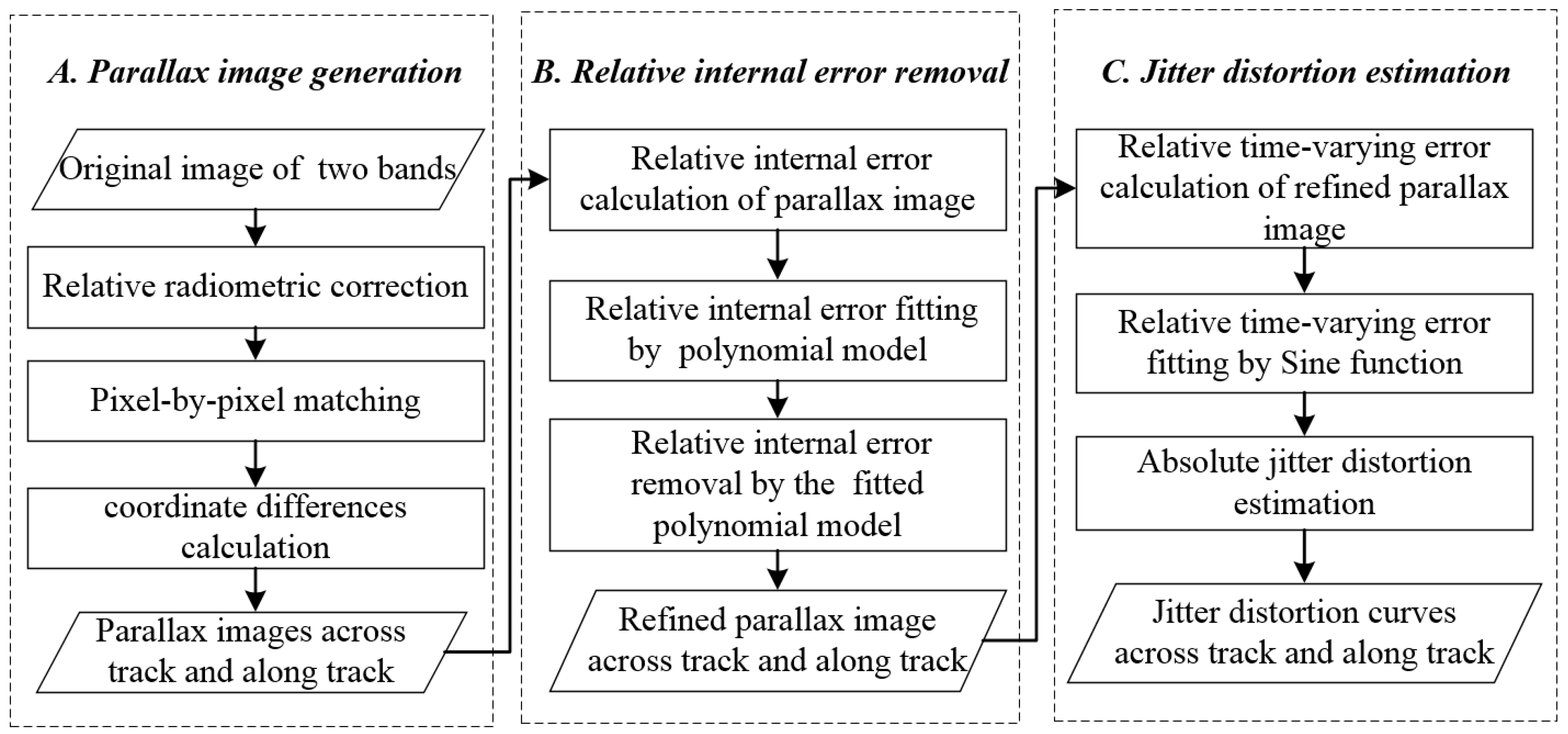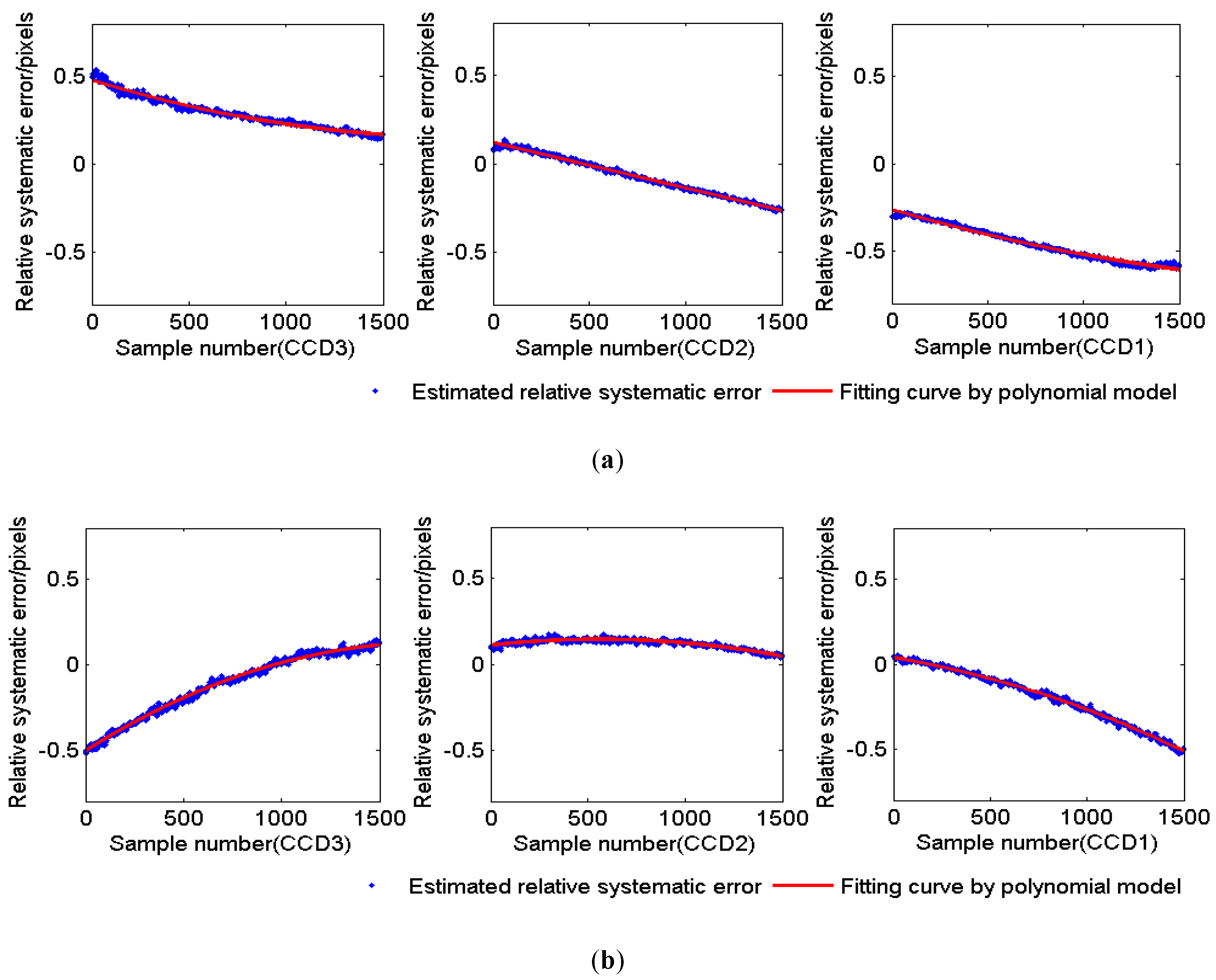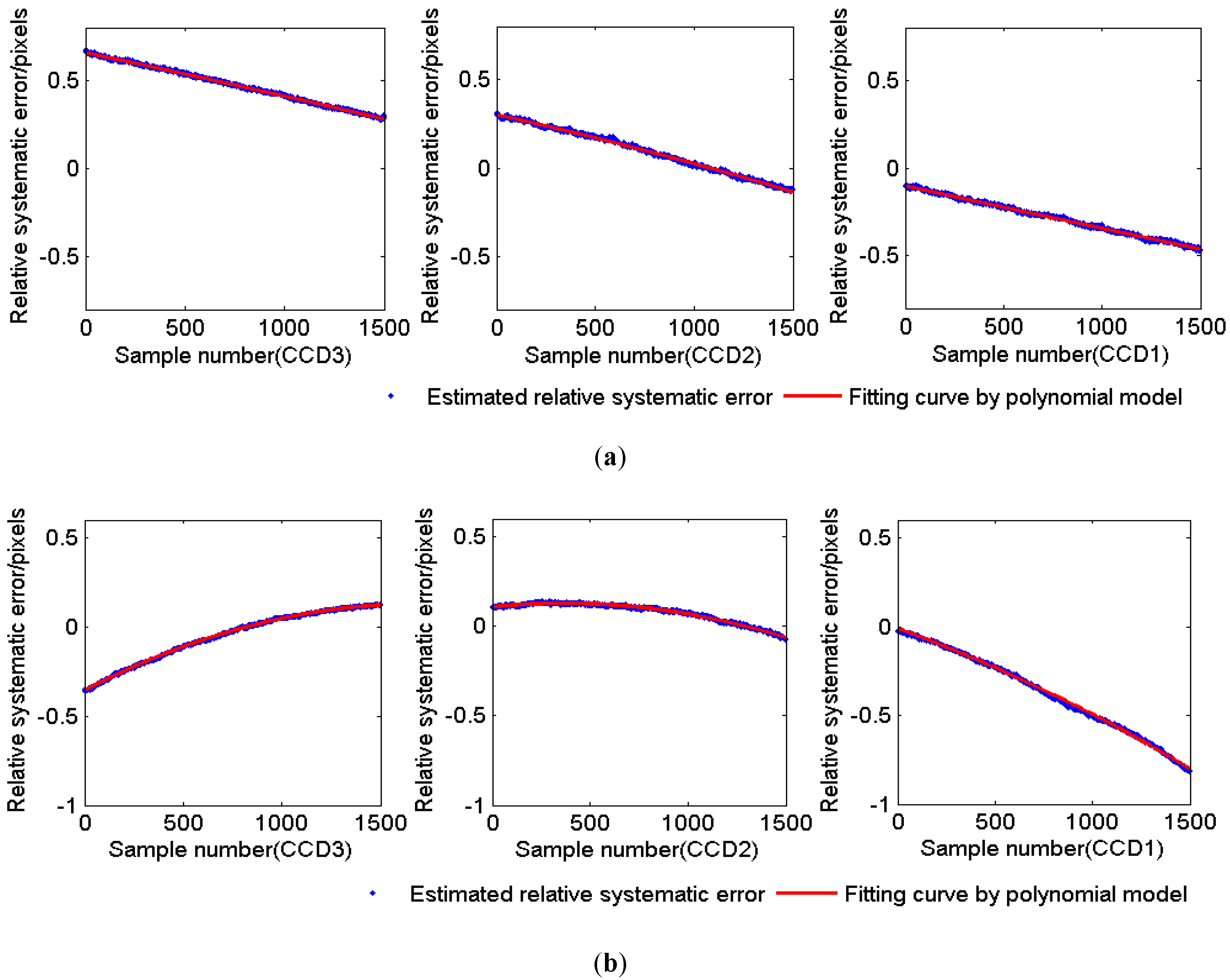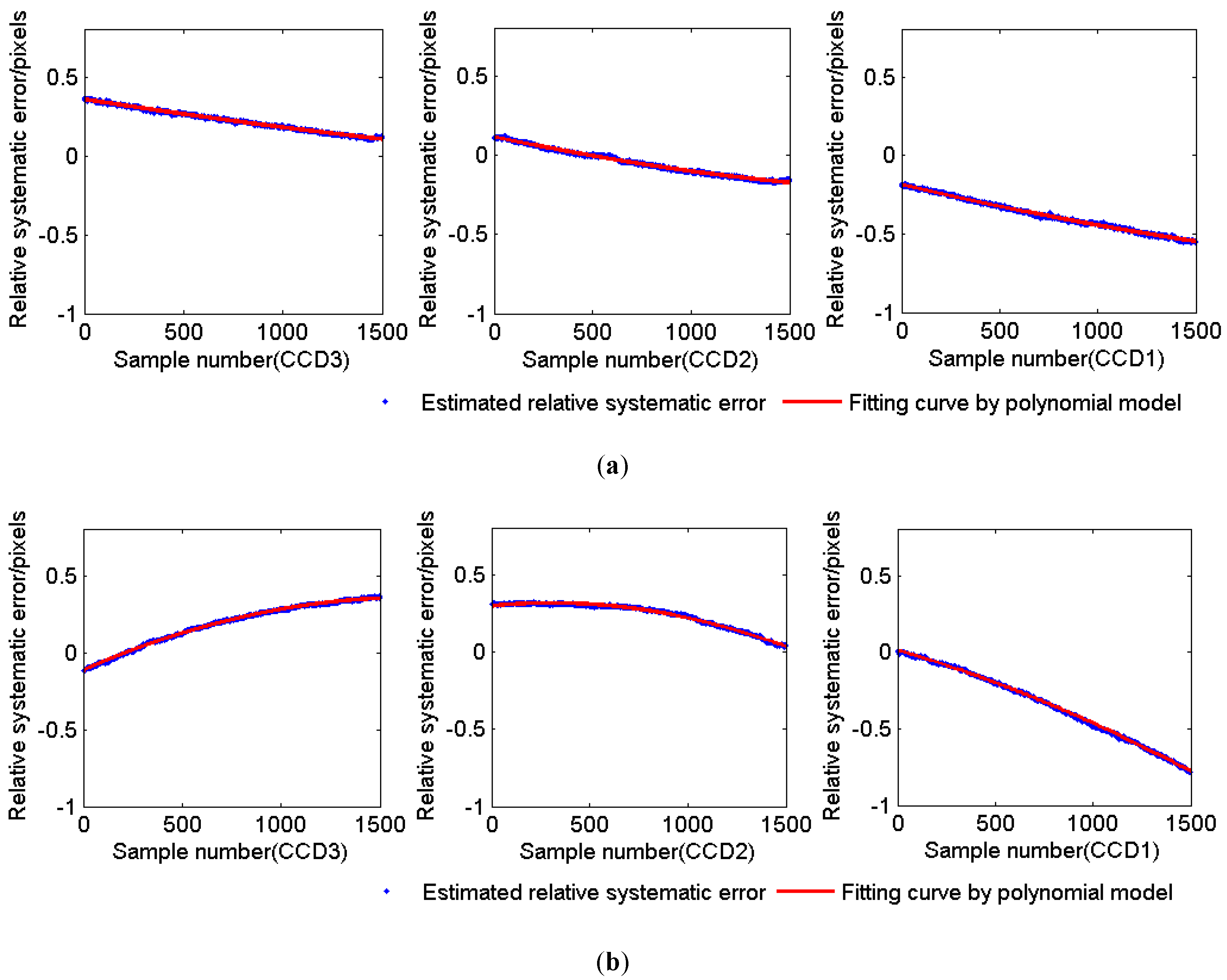An Improved Jitter Detection Method Based on Parallax Observation of Multispectral Sensors for Gaofen-1 02/03/04 Satellites
Abstract
:1. Introduction
2. Materials and Methods
2.1. Parallax Image Generation by Pixel-by-Pixel Matching
2.2. Relative Internal Error Removal
2.3. Jitter Distortion Estimation
3. Results
3.1. Data Description
3.2. Jitter Detection Results
3.2.1. Results of Band Combination B1–B2
3.2.2. Results of Band Combination B2–B3
4. Discussion
4.1. Consistency Analysis of Results from Two Band Combinations
4.2. Evaluation Results Using Ortho-Images
4.3. Comparison with the Conventional Method
5. Conclusions
Author Contributions
Funding
Acknowledgments
Conflicts of Interest
References
- Roques, S.; Jahan, L.; Rougé, B.; Thiebaut, C. Satellite attitude instability effects on stereo images. In Proceedings of the IEEE International Conference on Acoustics, Speech, and Signal Processing (ICASSP), Montreal, QC, Canada, 17–21 May 2004. [Google Scholar]
- Ayoub, F.; Leprince, S.; Binet, R.; Lewis, K.W.; Aharonson, O.; Avouac, J.P. Influence of Camera Distortions on Satellite Image Registration and Change Detection Applications. In Proceedings of the 2008 IEEE International Geoscience and Remote Sensing Symposium, Boston, MA, USA, 7–11 July 2008. [Google Scholar]
- Iwasaki, A. Detection and Estimation Satellite Attitude Jitter Using Remote Sensing Imagery. In Advances in Spacecraft Technologies; InTech: Rijeka, Croatia, 2011; pp. 257–272. [Google Scholar]
- Tong, X.; Ye, Z.; Xu, Y.; Tang, X.; Liu, S.; Li, L.; Xie, H.; Wang, F.; Li, T.; Hong, Z. Framework of Jitter Detection and Compensation for High Resolution Satellites. Remote Sens. 2014, 6, 3944–3964. [Google Scholar] [CrossRef] [Green Version]
- Robertson, B.C. Rigorous geometric modeling and correction of QuickBird imagery. In Proceedings of the IEEE International Geoscience and Remote Sensing Symposium, Toulouse, France, 21–25 July 2003. [Google Scholar]
- Ran, Q.; Chi, Y.; Wang, Z. Property and removal of jitter in Beijing-1 small satellite panchromatic images. In Proceedings of the International Archives of the Photogrammetry, Remote Sensing and Spatial Information Sciences, Beijing, China, 2008. [Google Scholar]
- Mattson, S.; Boyd, A.; Kirk, R.; Cook, D.A.; Howington-Kraus, E. HiJACK: Correcting spacecraft jitter in HiRISE images of Mars. In Proceedings of the European Planetary Science Congress, Potsdam, Germany, 2009. [Google Scholar]
- Mattson, S.; Robinson, M.; McEwen, A. Early Assessment of Spacecraft Jitter in LROC-NAC. In Proceedings of the 41st Lunar and Planetary Science Conference, Woodlands, TX, USA, 1–5 March 2010. [Google Scholar]
- Takaku, J.; Tadono, T. High Resolution DSM Generation from ALOS Prism-processing Status and Influence of Attitude Fluctuation. In Proceedings of the 2010 IEEE International Geoscience and Remote Sensing Symposium, Honolulu, HI, USA, 25–30 July 2010. [Google Scholar]
- Amberg, V.; Dechoz, C.; Bernard, L.; Greslou, D.; de Lussy, F.; Lebegue, L. In-Flight Attitude Perturbances Estimation: Application to PLEIADES-HR Satellites. In Proceedings of the SPIE Optical Engineering & Applications, International Society for Optics and Photonics, San Diego, CA, USA, 25–29 August 2013. [Google Scholar]
- Jiang, Y.; Zhang, G.; Tang, X.; Li, D.; Huang, W. Detection and Correction of Relative Attitude Errors for ZY1-02C. IEEE Trans. Geosci. Remote Sens. 2014, 52, 7674–7683. [Google Scholar] [CrossRef]
- Sun, T.; Long, H.; Liu, B.; Li, Y. Application of attitude jitter detection based on short-time asynchronous images and compensation methods for Chinese mapping satellite-1. Opt. Express 2015, 23, 1395–1410. [Google Scholar] [CrossRef] [PubMed]
- Tong, X.; Xu, Y.; Ye, Z.; Liu, S.; Tang, X.; Li, L.; Xie, H.; Xie, J. Attitude Oscillation Detection of the ZY-3 Satellite by Using Multispectral Parallax Images. IEEE Trans. Geosci. Remote Sens. 2015, 53, 3522–3534. [Google Scholar] [CrossRef]
- Tong, X.; Li, L.; Liu, S.; Xu, Y.; Ye, Z.; Jin, Y.; Wang, F.; Xie, H. Detection and estimation of ZY-3 three-line array image distortions caused by attitude oscillation. ISPRS J. Photogramm. Remote Sens. 2015, 101, 291–309. [Google Scholar] [CrossRef]
- Liu, S.; Tong, X.; Wang, F.; Sun, W.; Guo, C.; Ye, Z.; Ji, Y. Attitude Jitter Detection Based on Remotely Sensed Images and Dense Ground Controls: A Case Study for Chinese ZY-3 Satellite. IEEE J. Sel. Top. Appl. Earth Obs. Remote Sens. 2016, 9, 5760–5766. [Google Scholar] [CrossRef]
- Wang, M.; Zhu, Y.; Pan, J.; Yong, B.; Zhu, Q. Satellite jitter detection and compensation using multispectral imagery. Remote Sens. Lett. 2016, 7, 513–522. [Google Scholar] [CrossRef]
- Tong, X.; Ye, Z.; Li, L. Detection and Estimation of along-Track Attitude Jitter from Ziyuan-3 three-Line-Array Images Based on Back-Projection Residuals. IEEE Trans. Geosci. Remote Sens. 2017, 55, 4272–4284. [Google Scholar] [CrossRef]
- Tong, X.; Ye, Z.; Liu, S. Essential Technology and Application of Jitter Detection and Compensation for High Resolution Satellite. Acta Geod. Et Cartogr. Sin. 2017, 46, 1500–1508. [Google Scholar]
- Teshima, Y.; Iwasaki, A. Correction of Attitude Fluctuation of Terra Spacecraft Using ASTER/SWIR Imagery with Parallax Observation. IEEE Trans. Geosci. Remote Sens. 2008, 46, 222–227. [Google Scholar] [CrossRef]
- Delvit, J.M.; Greslou, D.; Amberg, V.; Dechoz, C.; de Lussy, F.; Lebegue, L.; Latry, C.; Artigues, S.; Bernard, L. Attitude assessment using Pleiades-HR capabilities. In Proceedings of the International Archives of the Photogrammetry, Remote Sensing and Spatial Information Sciences, Melbourne, Australia, 25 August 2012. [Google Scholar]
- Wang, P.; An, W.; Deng, X.; Yang, Y.; Sheng, W. A jitter compensation method for spaceborne line-array imagery using compressive sampling. Remote Sens. Lett. 2015, 6, 558–567. [Google Scholar] [CrossRef]
- Pan, J.; Che, C.; Zhu, Y.; Wang, M. Satellite jitter estimation and validation using parallax images. Sensors 2017, 17, 83. [Google Scholar] [CrossRef] [PubMed]
- Tang, X.M.; Xie, J.F.; Wang, X.; Jiang, W.S. High-Precision Attitude Post-Processing and Initial Verification for the ZY-3 Satellite. Remote Sens. 2015, 7, 111–134. [Google Scholar] [CrossRef]
- Wang, M.; Zhu, Y.; Jin, S.; Panab, J.; Zhu, Q. Correction of ZY-3 image distortion caused by satellite jitter via virtual steady reimaging using attitude data. ISPRS J. Photogramm. Remote Sens. 2016, 119, 108–123. [Google Scholar] [CrossRef]
- Wang, M.; Fan, C.; Pan, J.; Jina, S.; Chang, X. Image jitter detection and compensation using a high-frequency angular displacement method for Yaogan-26 remote sensing satellite. ISPRS J. Photogramm. Remote Sens. 2017, 130, 32–43. [Google Scholar] [CrossRef]
- Dinguirard, M.; Slater, P.N. Calibration of Space-Multispectral Imaging Sensors: A Review. Remote Sens. Environ. 1999, 68, 194–205. [Google Scholar] [CrossRef]
- Ackermann, F. Digital Image Correlation: Performance and Potential Application in Photogrammetry. Photogramm. Rec. 1984, 11, 429–439. [Google Scholar] [CrossRef]
- Gruen, A. Development and Status of Image Matching in Photogrammetry. Photogramm. Rec. 2012, 27, 36–57. [Google Scholar] [CrossRef]
- Wang, M.; Yang, B.; Hu, F.; Zang, X. On-orbit geometric calibration model and its applications for high-resolution optical satellite imagery. Remote Sens. 2014, 6, 4391–4408. [Google Scholar] [CrossRef]
- Jiang, Y.H.; Zhang, G.; Tang, X.; Li, D.; Wang, T.; Huang, W.; Li, L. Improvement and Assessment of the Geometric Accuracy of Chinese High-Resolution Optical Satellites. IEEE J. Sel. Top. Appl. Earth Obs. Remote Sens. 2015, 8, 4841–4852. [Google Scholar] [CrossRef]
- Hadar, O.; Fisher, M.; Kopeika, N.S. Image Resolution Limits Resulting from Mechanical Vibrations. Part III: Numerical Calculation of Modulation Transfer Function. Opt. Eng. 1992, 31, 581–589. [Google Scholar]
- Toutin, T. Review article: Geometric processing of remote sensing images: Models, algorithms and methods. Int. J. Remote Sens. 2004, 25, 1893–1924. [Google Scholar] [CrossRef]
- Poli, D.; Toutin, T. Review of developments in geometric modelling for high resolution satellite pushbroom sensors. Photogramm. Rec. 2012, 27, 58–73. [Google Scholar] [CrossRef]
- Tao, C.V.; Hu, Y. A comprehensive study of the rational function model for photogrammetric processing. Photogramm. Eng. Remote Sens. 2001, 67, 1347–1358. [Google Scholar]
- Fraser, C.S.; Dial, G.; Grodecki, J. Sensor orientation via RPCs. ISPRS J. Photogramm. Remote. Sens. 2006, 60, 182–194. [Google Scholar] [CrossRef]















| Satellites (Launch Year) | Main Results | Adopted Method | Pros | Cons |
|---|---|---|---|---|
| ASTER (1999) | Across track: 0.2 pixels, 1.5 Hz [19] | SWIR imagery with parallax observation | Independent of external data; Level-1B data products were used, no need to consider the impact of other errors | Lack of applicability of multi–CCDs images |
| Pleiades-HR (2011) | Across track: 0.18 pixels, 71.5 Hz; Along track: 0.25 pixels, 71 Hz [10] | Multispectral imagery with parallax observation | Independent of external data; low cost | The other relative error between two bands would affect the detect results. |
| ZY-3 (2012) | Across track: 0.5–1.5 pixels, 0.65 Hz; Along track: 0.2–0.6 pixels, 0.65 Hz [13] | |||
| HiRISE (2005) | Across track: 4–5 pixels, 1.4 Hz [2,7] | Staggered CCD images with parallax observation | Independent of external data; low cost | Limit to the overlap between the adjacent CCD images |
| Mapping satellite-1 (2010) | Along track: 0.10 pixels, 0.1 Hz; 0.05 pixels, 0.6 Hz; 0.05 pixels, 4 Hz [12] | |||
| ZY1-02C (2011) | Across track: 3.56 pixels, 0.3 Hz [22] | |||
| ALOS (2006) | Along track: 1 pixel, 6–7 Hz; Sub-pixel, 60–70 Hz [9] | Stereo images with parallax observation | Independent of external data; low cost | Topographic relief would affect the detect results. |
| QuickBird (2001) | Across track: 5 pixels, 1 Hz; 0.2 pixels, 4.3 Hz [2] | ortho–images | Distortion caused by jitter can be directly obtained. | Relying on external data |
| Beijing-1 (2005) | Across track: 0.5 pixels; 200 HZ [6] | linear objects in images | Independent of external data; low cost | Limited to detecting jitter across the track |
| Yaogan-26 (2014) | Across track: 0.02–0.05 arcsec, 100 Hz Across track: 0.01–0.05 arcsec, 100 Hz [25] | high–frequency angular displacement | attitude determination results combined with star sensor can be directly used for geometric preprocessing | Limit to observing bandwidth of attitude sensor |
| Image ID | Satellite ID | Imaging Date | Center Location | Image Size | Imaging Duration |
|---|---|---|---|---|---|
| Scene A | 03 | 2018.04.15 | E120.1 N36.9 | 4584 × 1536 × 3 | 5.12 s |
| Scene B | 04 | 2018.04.15 | E100.0 N43.0 | 4584 × 1536 × 3 | 4.83 s |
| Scene C | 02 | 2018.04.19 | E134.9 S16.3 | 4584 × 1536 × 3 | 5.20 s |
| Image ID | Direction | CCD No. | a2/b2 | a1/b1 | a0/b0 |
|---|---|---|---|---|---|
| Scene A | Across track | 1 | 5.66 × 10−8 | −3.14 × 10−4 | −2.62 × 10−1 |
| 2 | 2.09 × 10−9 | −2.61 × 10−4 | 1.22 × 10−1 | ||
| 3 | 8.67 × 10−8 | −3.37 × 10−4 | 4.79 × 10−1 | ||
| Along track | 1 | −1.20 × 10−7 | −1.89 × 10−4 | 3.92 × 10−2 | |
| 2 | −1.11 × 10−7 | 1.23 × 10−4 | 1.11 × 10−1 | ||
| 3 | −2.05 × 10−7 | 7.21 × 10−4 | −5.06 × 10−1 | ||
| Scene B | Across track | 1 | 3.04 × 10−9 | −2.45 × 10−4 | −1.02 × 10−1 |
| 2 | −2.84 × 10−8 | −2.49 × 10−4 | 3.02 × 10−1 | ||
| 3 | −8.59 × 10−9 | −2.39 × 10−4 | 6.59 × 10−1 | ||
| Along track | 1 | −8.19 × 10−8 | −4.01 × 10−4 | −1.35 × 10−2 | |
| 2 | −1.48 × 10−7 | 1.08 × 10−4 | 1.08 × 10−1 | ||
| 3 | −1.69 × 10−7 | 5.74 × 10−4 | −3.57 × 10−1 | ||
| Scene C | Across track | 1 | 3.62 × 10−8 | −2.97 × 10−4 | −1.83 × 10−1 |
| 2 | 5.03 × 10−8 | −2.70 × 10−4 | 1.19 × 10−1 | ||
| 3 | 1.89 × 10−8 | −1.97 × 10−4 | 3.60 × 10−1 | ||
| Along track | 1 | −9.83 × 10−8 | −3.84 × 10−4 | 1.61 × 10−2 | |
| 2 | −1.99 × 10−7 | 1.21 × 10−4 | 3.01 × 10−1 | ||
| 3 | −1.71 × 10−7 | 5.69 × 10−4 | −1.14 × 10−1 |
| Image ID | Error Type | Frequency/Hz | Amplitude/Pixels | Phase/Rad |
|---|---|---|---|---|
| Scene A | Relative | 1.1012 | 0.6819 | 1.8017 |
| Absolute | 1.1012 | 1.1694 | −0.0650 | |
| Scene B | Relative | 1.2046 | 0.7713 | −1.5587 |
| Absolute | 1.2046 | 1.2935 | 2.8509 | |
| Scene C | Relative | 1.0954 | 0.0453 | 3.0147 |
| Absolute | 1.0954 | 0.0774 | 1.1471 |
| Image ID | Mean Error | RMSE | Min. Error | Max. Error |
|---|---|---|---|---|
| Scene A | 0.0197 | 0.0453 | −0.0918 | 0.0892 |
| Scene B | −0.0231 | 0.0361 | −0.0620 | 0.0201 |
| Scene C | 0.0024 | 0.0114 | −0.0342 | 0.0498 |
| Image ID | CCD No. | a2 | a1 | a0 |
|---|---|---|---|---|
| Scene A | 1 | 3.35 × 10−8 | −2.37 × 10−4 | −1.87 × 10−1 |
| 2 | −2.26 × 10−9 | −1.71 × 10−4 | 7.46 × 10−2 | |
| 3 | 3.33 × 10−8 | −1.85 × 10−4 | 3.13 × 10−1 | |
| Scene B | 1 | −6.35 × 10−9 | −1.66 × 10−4 | −6.86 × 10−2 |
| 2 | −2.98 × 10−9 | −2.00 × 10−4 | 2.23 × 10−1 | |
| 3 | −1.13 × 10−8 | −1.81 × 10−4 | 5.00 × 10−1 | |
| Scene C | 1 | 1.28 × 10−8 | −1.99 × 10−4 | −1.36 × 10−1 |
| 2 | 1.98 × 10−8 | −1.55 × 10−4 | 7.01 × 10−2 | |
| 3 | 1.44 × 10−8 | −1.34 × 10−4 | 2.42 × 10−1 |
| Image ID | Error Type | Frequency/Hz | Amplitude/Pixels | Phase/Rad |
|---|---|---|---|---|
| Scene A | Relative | 1.1013 | 0.5850 | 1.7865 |
| Absolute | 1.1013 | 1.1861 | −0.0335 | |
| Scene B | Relative | 1.2046 | 0.6565 | −1.5760 |
| Absolute | 1.2046 | 1.3015 | 2.8918 | |
| Scene C | Relative | 1.0952 | 0.0380 | 2.9421 |
| Absolute | 1.0952 | 0.0767 | 1.1214 |
| Image ID | Mean Error | RMSE | Min. Error | Max. Error |
|---|---|---|---|---|
| Scene A | −0.0013 | 0.0281 | −0.0404 | 0.0401 |
| Scene B | 0.0019 | 0.0378 | 0.0537 | −0.0537 |
| Scene C | 0.0003 | 0.0068 | −0.0098 | 0.0097 |
| Image ID | Frequency/Hz | Amplitude/Pixels | Phase/Rad |
|---|---|---|---|
| Scene A | 1.0991 | 1.1498 | −0.0339 |
| Scene B | 1.2020 | 1.2842 | 2.9014 |
| Image ID | Mean Error | RMSE | Min. Error | Max. Error |
|---|---|---|---|---|
| Scene A | −0.0014 | 0.0610 | −0.1150 | 0.1082 |
| Scene B | −0.0015 | 0.0268 | −0.0578 | 0.0519 |
| Image ID | Band Combination | Error Type | Frequency/Hz | Amplitude/Pixels | Phase/Rad |
|---|---|---|---|---|---|
| Scene A | B1–B2 | Relative | 1.1012 | 0.6811 | 1.7991 |
| Absolute | 1.1012 | 1.1679 | −0.0675 | ||
| B2–B3 | Relative | 1.1013 | 0.5838 | 1.7828 | |
| Absolute | 1.1013 | 1.1837 | −0.0371 | ||
| Scene B | B1–B2 | Relative | 1.2048 | 0.7701 | −1.5653 |
| Absolute | 1.2048 | 1.2911 | 2.8443 | ||
| B2–B3 | Relative | 1.2049 | 0.6552 | −1.5820 | |
| Absolute | 1.2049 | 1.2987 | 2.8754 | ||
| Scene C | B1–B2 | Relative | 1.0961 | 0.0446 | 3.0083 |
| Absolute | 1.0961 | 0.0763 | 1.1405 | ||
| B2–B3 | Relative | 1.0953 | 0.0379 | 2.9429 | |
| Absolute | 1.0953 | 0.0767 | 1.1222 |
| Image ID | Scene A | Scene B | Scene C |
|---|---|---|---|
| Conventional method (pixel) | 0.209 | 0.200 | 0.175 |
| Proposed method (pixel) | 0.141 | 0.122 | 0.126 |
| Improving ratio (%) | 32.54% | 39.00% | 28.00% |
© 2018 by the authors. Licensee MDPI, Basel, Switzerland. This article is an open access article distributed under the terms and conditions of the Creative Commons Attribution (CC BY) license (http://creativecommons.org/licenses/by/4.0/).
Share and Cite
Zhu, Y.; Wang, M.; Cheng, Y.; He, L.; Xue, L. An Improved Jitter Detection Method Based on Parallax Observation of Multispectral Sensors for Gaofen-1 02/03/04 Satellites. Remote Sens. 2019, 11, 16. https://doi.org/10.3390/rs11010016
Zhu Y, Wang M, Cheng Y, He L, Xue L. An Improved Jitter Detection Method Based on Parallax Observation of Multispectral Sensors for Gaofen-1 02/03/04 Satellites. Remote Sensing. 2019; 11(1):16. https://doi.org/10.3390/rs11010016
Chicago/Turabian StyleZhu, Ying, Mi Wang, Yufeng Cheng, Luxiao He, and Lin Xue. 2019. "An Improved Jitter Detection Method Based on Parallax Observation of Multispectral Sensors for Gaofen-1 02/03/04 Satellites" Remote Sensing 11, no. 1: 16. https://doi.org/10.3390/rs11010016





